
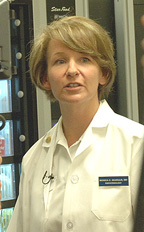


| T H E N I H C A T A L Y S T | J A N U A R Y – F E B R U A R Y 2007 |
|
|
|
Another Step in the Strategic Plan for NIH Obesity researchCC'S METABOLIC CLINICAL RESEARCH UNIT MAKES IT'S DEBUT |
 |
 |
 |
 |
|
NIDDK
Scientific Director
|
Monica
Skarulis, chief of the
Clinical Endocrine Section, Clinical Endocrinology Branch, NIDDK
|
Merel
Kozlosky, supervisory
metabolic dietitian
|
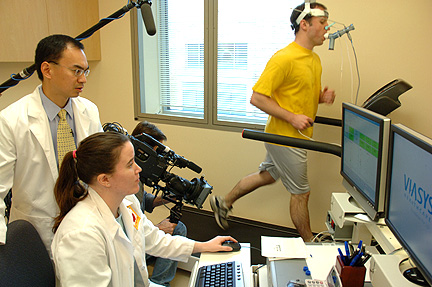 |
|
In
a corner of the exercise room,
Megan Rothney,
predoctoral fellow in the Clinical Endocrinology Branch, NIDDK, simultaneously
monitors the pulmonary, cardiac, and metabolic parameters of a volunteer
treadmill runner, overseen by Kong Chen, director of the new unit’s
Metabolic Research Core
|
Not one calorie escapes from the Metabolic Clinical Research Unit, a roomy new facility tucked into two floors in the Clinical Center’s southwest wing.
The state-of-the-art facility opened its doors on January 25 and is expecting its first round of patients and volunteers by winter’s end.
The unit is a contrast of extremes—with extra-wide gurneys and wheelchairs, reinforced toilets, and special scales to accommodate morbidly obese patients, countered with advanced devices to keep track of every morsel eaten and calorie burned, measuring metabolic changes down to the molecular level.
Although the focus is on obesity, the unit intends to recruit subjects of all body designs to understand the basic science of human metabolism and the physical and behavioral processes involved in weight gain and weight loss. It is expected that the unit will attract researchers across NIH who are variously interested in such issues as the metabolic changes seen in organ transplants, cancer, HIV, and many other diseases.
The unit is greater than the sum of its parts. Much of its equipment exists elsewhere, but not all in one place. Consider the Bod Pod and DXA to measure body composition, the physical activity monitors, sleep-monitoring equipment, ten inpatient rooms, and three metabolic suites to measure oxygen–carbon dioxide exchange minute by minute—precisely enough to determine calories burned from fats versus carbohydrates. Added up, the unit is intended to give NIH researchers "an unfair advantage" in understanding metabolism, says Monica Skarulis, an NIDDK senior clinical investigator.
"We are set up to study human metabolism in a way that we were never able to do before," says Marvin Gershengorn, NIDDK scientific director, who describes the unit as a melding of the fields of metabolism, endocrinology, nutrition, cardiovascular biology, gastroenterology, hepatology, genetics, and behavioral sciences.
Kong Chen of the NIDDK, an expert in metabolism and nutrition recently recruited from Vanderbilt University in Nashville, Tenn., speaks of the basic and translational science that he hopes to accomplish as director of the Metabolic Research Core at the unit. "As an extramural scientist three months ago, I couldn’t do this," Chen says.
About a dozen clinical protocols have worked their way through the IRB and are ready to be implemented, says Gershengorn, a principal architect of the unit’s concept and champion of its development. Most are headed by NIDDK investigators; some of the others, which originate in NICHD, are moving over from the CC pediatric unit.
Many more protocols are in the pipeline. Gershengorn has heard of interested parties in NCI, NHLBI, NIDA, NIMH, and NIAAA, exactly the kind of cross-campus interest the unit was established to accommodate.
"This is really the
most modern and cutting-edge place to do research," says John
Gallin, CC director. "We can provide really precise phenotyping of
patients with any type of disease. . . . We want people to know the resource
is there." ![]()
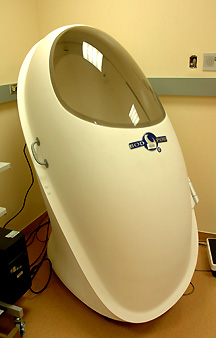 |
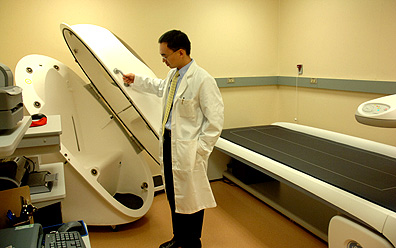 |
|
The
Bod Pod:
A person sits inside, with a view of the outside world, and his or her
total body density is determined within a couple of minutes
|
The
seat inside the Bod Pod:
Kong Chen, director of the Metabolic Research Core at the Metabolic Clinical
Research Unit, reveals the pod’s inner sanctum; behind him is the
unit’s DXA (dual-energy X-ray absorptiometry) table. "Using
the [DXA’s] total-body mode," Kong says, "we can measure
total fat, lean, and bone contents, as well as distributions, with only
a low dose of radiation exposure (about one day of background exposure).
The unique feature of our system is its expanded capacity to measure patients
up to 450 pounds."
|
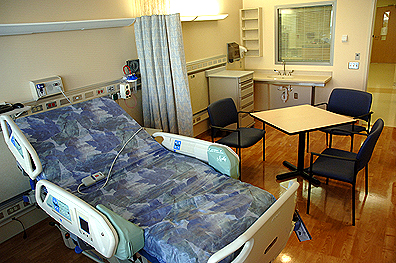 |
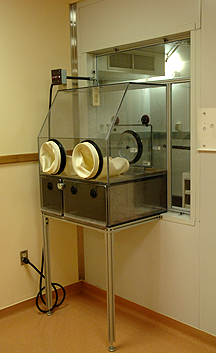 |
|
The
bed of choice:
The above 460-pound capacity bed can measure the weight of a person in
bed and can readily convert into the chair position; it is the bed that
will be used throughout the metabolic unit.
|
Airtight:
One of the unit’s three rapid-response respiratory suites, where
people can be sealed in for 24 hours, food delivered and removed via sleeves,
for a precise determination of metabolic rate and calorie dynamics
|